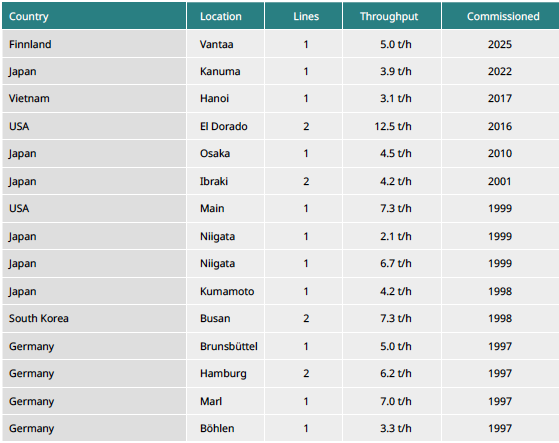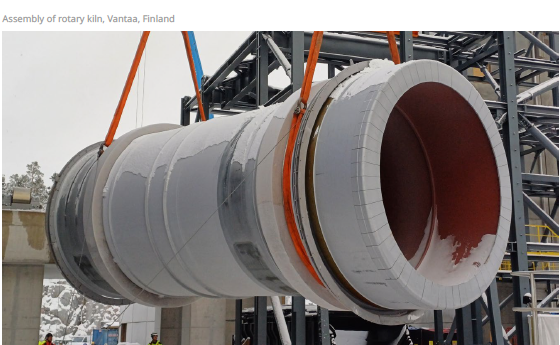Hazardous waste treatment
Hazardous waste treatment
Technology: rotary kiln with secondary combustion chamber
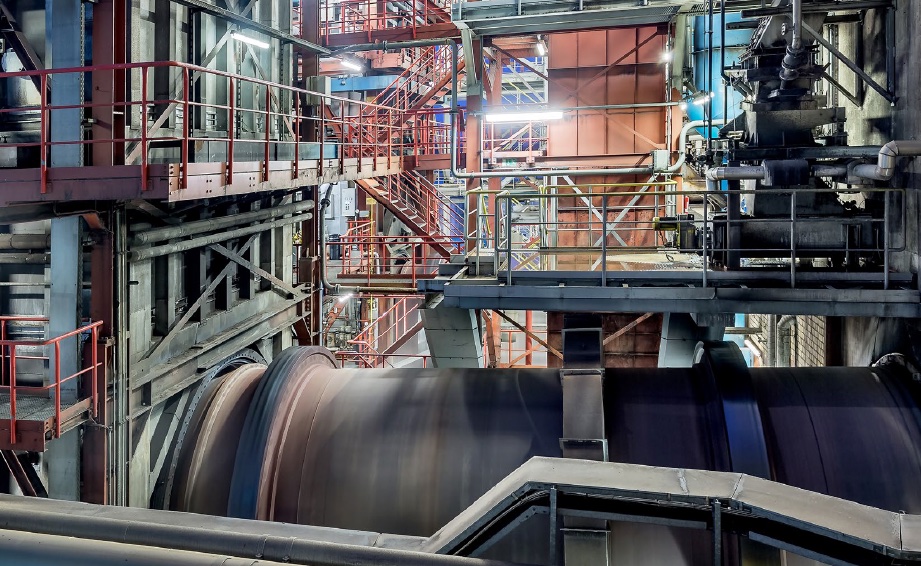
Incinerating hazardous waste in a rotary kiln
Hazardous waste facilities are unique in the thermal treatment of waste. Each plant has its own requirements and needs customised planning.
If you’re looking for a professional partner, Kanadevia Inova will take you all the way from the conceptual phase, engineering, construction and commissioning to service support over the entire life cycle of the installation.
Waste types and treatment
Legally speaking, “hazardous waste” is a term encompassing around 400 types of waste in the
European list of waste (LoW). They include:
- Residues from the chemical industry production processes
- Laboratory chemicals
- Pesticides
- Hospital waste, infectious material
- Highly contaminated industrial waste
While the treatment of hazardous waste essentially involves the safe inertisation (destruction) of the hazardous substances contained in the waste, issues such as recycling management and energy recovery are also playing an increasingly important role. Hazardous waste has to be incinerated at a higher temperature than municipal waste: 1,100 °C as opposed to 850 °C.
With only a few exceptions, hazardous waste is incinerated in rotary kilns with a secondary combustion chamber, a system with a proven track record of more than 50 years of reliable operation.
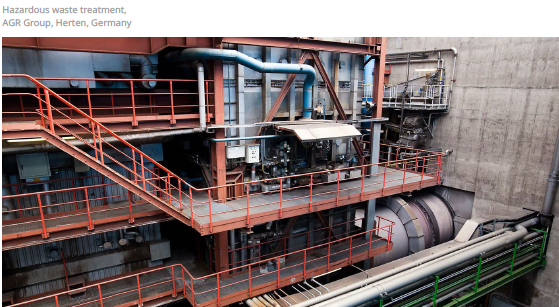
Reliable Partner
Over the past decades, Kanadevia Inova has delivered more than 100 projects with rotary kiln technology for the treatment of hazardous waste. Thanks to this extensive project experience, we have been able to continuously update and deepen our expertise. Our qualified engineers are experts in the complex field of handling hazardous waste and always use the latest technologies to ensure the highest standards of safety and efficiency.
We’re there to guide and support you throughout the entire life cycle of your project, from the preliminary study to consulting, concept development, overall planning, engineering and project planning and execution. Beyond this we offer comprehensive service throughout the entire life cycle of your installation.
Involving Kanadevia Inova in the preliminary study early on gives all the parties involved assurance from the outset that the project will be delivered as effectively as possible.
In addition to the rotary kiln and secondary combustion chamber, our complete package also includes other customised system components including waste heat boilers, systems for generating power and heat from steam, and flue gas treatment units.
Choice of plant design
The layout of the rotary kiln and the overall plant can vary depending on different plant designs and country-specific requirements. In the overall planning process we also draw on the experience of operators to make sure the hazardous waste treatment plant is ultimately fit for purpose. The examples in the table below illustrate the potential complexity that has to be considered in planning.
When it comes to overall planning, what counts is experience in the engineering, construction and operation of waste treatment plants. We always make sure the following boxes are checked:
- The approach makes economic sense in terms of investment and operating costs
- The chosen waste treatment technologies are sustainable and safe
- All the relevant rules and requirements are complied with
- The treatment costs are competitive
- The solution is highly flexible and can be adapted to future changes in requirements
- The plant contributes to circularity (high energy efficiency and maximum utilisation of residual materials)
- Proven technologies such as the rotary kiln and flue gas scrubbers are used
- Flexibly dimensioned flue gas scrubbing to respond to fluctuations in flue gas volume and composition
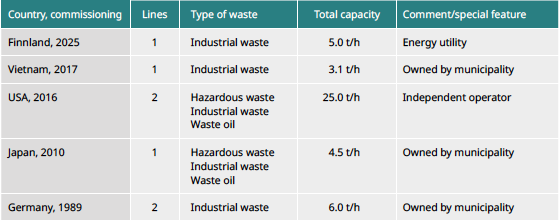
Plant technology
The plant technology of a hazardous waste treatment plant comprises several components. The process begins with the receipt and storage of the waste in specially secured containers and areas, depending on its nature. The waste is fed into the incinerator either directly or in processed form to maximise the efficiency of the incineration process.
Incineration at high temperatures is required to safely destroy any environmentally harmful organic compounds that may be contained in the waste. Hazardous waste incineration plants therefore generally use rotary kilns with a secondary combustion chamber. The rotary kiln consists of an inclined, rotating cylinder that continuously transports the waste through the incineration process. In the combustion chamber, the waste is burnt at temperatures of 900 °C and higher. The rotation of the kiln ensures uniform mixing and complete combustion, allowing a variety of wastes, including liquids, solids and sludge, to be treated efficiently. The secondary combustion chamber ensures the complete burnout of the waste gases from the upstream rotary kiln (residual organics, entrained solid particles and CO strands) and the legally required two-second resident time at 1,100 °C.
In addition to the feeding of waste into the rotary kiln, suitable liquid and gaseous waste can also be fed into the inlet area of the secondary combustion chamber for treatment.
The resulting waste gases are cleaned in a multi- stage process. Particles are filtered out of the exhaust gas by a fabric filter. Chemical scrubbers neutralise acidic exhaust gas components such as hydrogen chloride and sulphur dioxide. In addition, heavy metals, dioxins and furans are separated in an activated carbon filter.
The heat generated during combustion is efficiently utilised to generate energy. The waste heat boiler converts the thermal energy into steam, which can then generate electricity in a turbine with a generator, be used as process heat or fed into local district heating networks. This way the plant not only contributes to the disposal of hazardous waste, but also to the energy supply. Continuous monitoring and control using state-of-theart sensors and control technology ensures the safe and efficient operation of the plant. Emergency systems and regular maintenance also contribute to safety.
Hazardous waste incineration plant – general concept
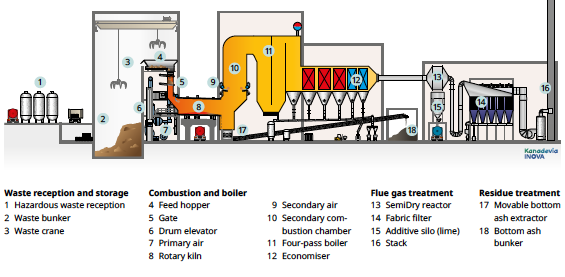
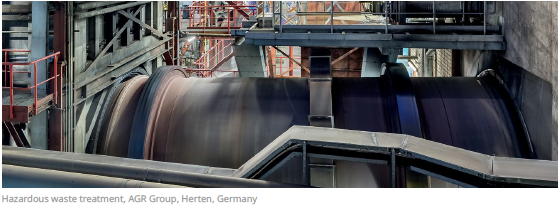
Rotary kiln
The rotary kiln consists of a drum tube lined with refractory material designed according to the thermal, chemical and mechanical loads. Rotary tubes can be up to 15 metres long and up to 5.5 metres in outer diameter.
The drum tube rotates slowly and is slightly inclined towards the horizontal in the direction of flow. The residence time of the waste materials in the incinerator chamber is determined by the rotational speed and inclination. At temperatures above 900 °C the residence time is more than 60 minutes. During operation, the jacket temperature of the rotary kiln reaches over 300 °C. High-temperature resistant seals and negative pressure in the entire system prevent the escape of environmentally harmful exhaust gases.
Feeding
Depending on its condition, the delivered waste is stored either in the tank farm or in special containers or drums. Larger-size solid waste materials can be shredded. Drums and IBCs can be fed in directly or processed.
Processing takes place near the rotary kiln head, where the waste is homogenised and fed in, for example, using a piston pump. The rotary kiln processes pasty, solid, liquid or gaseous waste, while the secondary combustion chamber only accepts liquid or gaseous media.
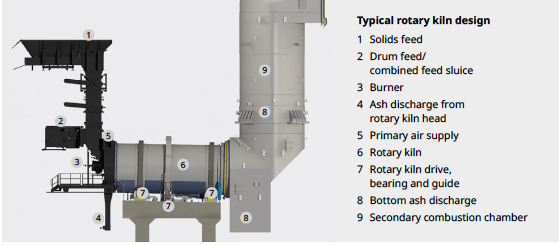
Design-to-Service
Service points are an important detail when it comes to carrying out maintenance work efficiently. The relevant system components can be moved sideways to provide easy access. Depending on the size and complexity of the system, we provide one or more service points at strategic positions.
These are located, for example
- at the head of rotary kiln (see image)
- in the feed
- at the bottom ash extractor (see image)
This reduces the work and cost involved in revisions.
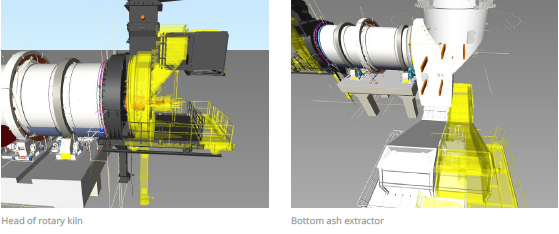
Design parameters
Various factors have a significant influence on the design of the rotary kiln and secondary combustion chamber: the types and volumes of waste to be treated, the energy input into the rotary kiln and secondary combustion chamber, the wastespecific burnout rates and the desired mixing in the rotary kiln. The following table provides an overview of the main plant design parameters:
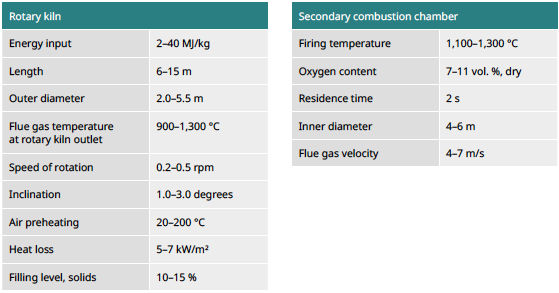
Excerpt reference list
